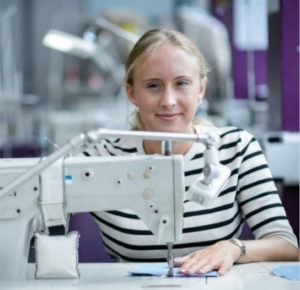Fashion Skills For East Londoners – A Vision For The Future
Three high-impact solutions to drive fashion skills development in east London
Introduction
OUR VISION IS TO CREATE A TALENT PIPELINE SO THAT THE FASHION INDUSTRY CAN ACCESS THE SKILLED WORKFORCE IT NEEDS TO THRIVE, AND EAST LONDONERS CAN DEVELOP GREAT CAREERS IN FASHION.
The Fashion District(1) has formed to prepare for and facilitate a step-change in London’s ability to become a world leader in fashion. It commissioned a report by BOP Consulting in March 2017(2) that outlined the key structural barriers faced by the sector in east London – access to skills, space and finance.
“There is an urgent need to build capacity, and promote innovation and resilience across the whole value chain. In order to achieve this, the sector will need to overcome structural barriers including access to skills, space, and funding.”
(BOP Consulting, 2017).
The Fashion District Skills Group(3) gathered baseline data about the skills agenda and outlined potential solutions to the challenges they found. The group focused on understanding how the fashion industry can access the right skills to meet the business needs and how local people can access these opportunities.
(3) Members include Newham College of Further Education, UK Fashion & Textiles Association (UKFT), British Fashion Council (BFC), London College of Fashion, UAL, London Legacy Development Corporation (LLDC), Greater London Authority (GLA) and Fashion Angel.

Image Description: A woman smiles at the camera whilst working at a workshop table. She wears a black Hijab and a white and black patterned top. Photo Credit: Newham College.
An Opportunity In The East
The fashion industry in east London is experiencing a period of renaissance. There has never been a better time for the industry to come together to create a supportive infrastructure to encourage growth:
• The creative industries in London generate £42bn per annum.(4)
• The creative economy accounts for 1 in 6 jobs in the capital.(4)
• Fashion in east London and the Upper Lea Valley now contributes £1.4 billion in GVA – up by £500m (57%) between 2010 and 2015. (5)
• At the start of 2016, 36,200 people were directly employed in fashion retail, design,
manufacture, distribution and advertising – an increase of 10,900 jobs since 2010.(2)
• East London is home to 23% of the capital’s fashion enterprises and employment and is driving the growth of London’s fashion design, retail and manufacturing.(2)
This opportunity will depend on its access to the right mix of talent and training. The Fashion District Skills Group identified key gaps between the supply of talent and industry need, and offered three recommendations to bridge the gap. Effective and collective action now will ensure that the industry can access the skills it needs to optimize growth and maximise the financial and cultural impact for London.
“CRUCIAL TO THE INDUSTRY’S ABILITY TO MAXIMISE EAST LONDON’S ACCELERATED GROWTH IS ITS ACCESS TO TALENT, TRAINING AND SKILLS PROVISION. IT IS ESTIMATED A FURTHER 15,000 JOBS COULD BE GENERATED IN THE AREA IF A PIPELINE OF SKILLED WORKERS ADDRESSING EMPLOYER NEEDS AND SKILLS GAPS COULD BE CREATED.”
(BOP Consulting, 2017).

Image Description: Two rails of clothes – all hang from wooden hangers.
Key Research Findings
GAPS IN MANUFACTURING SKILLS
85% of fashion businesses surveyed struggle to recruit in key roles including sewing machinists, cloth cutters, pattern cutters, finishing, production management, quality control and roles requiring CAD/CAM and office administrative skills.(6)
13% of courses available in London are targeted towards manufacturing skills and 14% of jobs in demand are for manufacturing.(7) However manufacturers still struggle to fill jobs suggesting the courses do not fit industry needs.(6)
The rising demand for British-made goods and subsequent efforts to re-shore are creating opportunities for employment and growth.(6) However an aging workforce, and the threat Brexit poses on the international/EU workforce means industry will need to build a sustainable domestic talent pipeline.(6)
Europe currently dominates creative and hand craftsmanship within the fashion industry.(8) The development of any new skills training should consider these elements to protect the UK’s international reputation for quality and creativity.
GAPS IN HEAD OFFICE AND DIGITAL SKILLS
Over 57% of retailers struggle to find employees for skilled head office roles within the fashion sector.(9) 58% of job roles currently being advertised are head-office positions but only 25% of courses within London are designed as direct pathways into these areas.(7)
The most difficult roles to recruit are skilled workers for analytical roles (especially customer insight), digital (content creation and social media) and technical roles (CRM knowledge, systems analysis), merchandising, buying and supply chain management.(9)
It is estimated that in the next five years 50 – 60,000 cutting-edge digital and predominantly head office-based roles will be urgently required.(9)
GAPS IN ENTERPRISE SKILLS
The increase in disruptive, technological, and low-cost business models has created a rich context for strong organic growth of micro fashion business and retail SMEs.(8)
There is, however, a high failure rate in early stage fashion start-ups as enterprise skills are not prioritised in design courses and start-ups don’t generally have the funds for external business support.(10)
Key enterprise skills most often lacking within start-ups are strategic thinking & planning, sourcing & production management, financial modelling & planning, sales,
marketing & digital, and leadership & management.(6)
MISALIGNMENT OF SKILLS PROVISION TO CAREERS IN DEMAND
There are currently few industry-recognized or professionally accredited courses, and those that do exist are poorly aligned to the skills in demand.
Of the 903 courses in 19 fashion related subject areas delivered by London HE and FE providers, 36% are nonaccredited introductory, beginner, or hobby short courses – meaning that over a third of courses are unsuitable for professional development.(7)
The sheer range of course on offer, and the difficulty in distinguishing between the skills they develop and destinations they support, is confusing both for employers and students wishing to build their careers in fashion.
With design/making dominating public perception of a typical fashion career, it is not surprising that in response to consumer demand, design-based fashion courses account for 55% of training provision in London.(7) However, only 31% of jobs in demand in industry are design-based, leading to a surplus of skilled designers and shortage of workers for other key roles.(7)
FUTURE-PROOFING
Aside from the current skills gaps, anticipating future skills needs is critical. Soft skills, creativity and knowledge of sustainability and ethical practices are likely to be
increasingly important.(8)
66% of global millennials are willing to spend more on brands that are sustainable, demanding sustainability within the system and circular economy principles throughout the value chain.(8)
Rapid advances in robotics, big data and artificial intelligence are beginning to disrupt entire industries across the UK. It is estimated that ten million UK job roles will be replaced or reframed by technology.(11)
These global forces will drive the need for new skillsets. 65% of children entering primary school today will fill jobs that do not currently exist that a balance of technical and soft skills, such as adaptability, problem-solving, creativity, social skills and emotional intelligence will be critical.(11)
The current emphasis on STEM subjects within schools addresses some aspects of the UK’s productivity challenge, but poses a real threat to the creative services industries,
with a severe shortage of Fashion & Textiles provision in pre-16 learning (e.g. GCSEs), and Design & Technology GSCES entries dropping 11% since 2016.(12)
If creative industries, including fashion, are to have access to a wide talent pool in the future, school curricula will need to change actively to invest in and promote creative
subjects to students and parents.
ACCESSIBILITY & ALTERNATIVE PATHWAYS INTO INDUSTRY IN EAST LONDON
‘East London is a complex environment where it is clear that a strong skills offer is critical to the future health of its economy’.(13) The mismatch between local skills levels and local employment opportunities is a major constraint to the great potential for local people to build sustainable careers in fashion.
Many local residents face significant barriers to learning and do not experience a linear progression from school through further or higher education to well paid jobs.(13) A better alignment of vocational training to local jobs could create a powerful, virtuous cycle in raising the economic prosperity of individuals, communities and the London economy.

Image Description: A woman works at a sewing machine. She is smiling at the camera. She is white and has blonde hair, she wears a navy and white striped top.
Three Solutions To Grow The Workforce
TO SUPPORT THE REALISATION OF THE NEW VISION FOR FASHION SKILLS DEVELOPMENT, AN INDUSTRY-LED MODEL WILL CONNECT EMPLOYERS, TRAINING PROVIDERS, LOCAL AUTHORITIES AND LOCAL PEOPLE.
A joint board that combines the strengths of design, manufacturing, retail, further education, higher education and the east London Boroughs will develop a strategic and collaborative approach to skills development across the pipeline. It will deliver three high impact solutions that support the Fashion District ambition to establish fashion as a major cultural draw in east London and a driver of economic growth.
THE THREE SOLUTIONS AIM TO:
• better prepare east Londoners for jobs in fashion.
• address skills shortages and gaps across the supply pipeline and assist the growth of the industry.
• bring together training providers and employers to co-design interventions and investment that will boost training provision and workforce development.
1. Communication
OUR FIRST SOLUTION: COMMUNICATION
MAKE FASHION CAREERS IN EAST LONDON ASPIRATIONAL, EXCITING AND ACCESSIBLE
Four actions to build excitement and ambition around fashion as a career:
RAISE THE PROFILE OF FASHION CAREERS IN EAST LONDON
• work with employers to define a medium term pipeline of skills demand.
• build the business case for the importance of fashion to London’s cultural and financial performance.
• promote fashion careers to school leavers, their parents and adult learners.
IMPROVE INFORMATION ABOUT FASHION CAREERS IN EAST LONDON
• improve Information Advice and Guidance for schools, colleges, career advisors and job centres and partner with existing successful models.
• host marketing events, endorsed by employers, including ‘Industry Advice to Advisors’.
• nominate local industry leaders to promote meaningful work experience and sustainable employment opportunities.
CLEAR SIGNPOSTING OF INDUSTRY RECOGNISED QUALITY PROVISION
• signpost industry approved training and how to access it, potentially via a single website endorsed by employers and linking to provider sites and information.
• improve information on job roles, entry routes, pay expectations and progression.
DEVELOP A NETWORK OF FASHION CAREERS CHAMPIONS
• invite business leaders to become careers champions as part of the Local Enterprise Network created by the GLA.(14)
2. Talent Pipelines
OUR SECOND SOLUTION: TALENT PIPELINES MAKE TALENT PIPELINES INTO THE INDUSTRY CLEAR, AND PROGRESSION PATHWAYS WITHIN THE INDUSTRY SIMPLE

Image Description: Two pairs of hands work on a colourful cross stitch.
Five actions to inspire and motivate a supply of talent across fashion sub-sectors.
SIMPLIFY AND SHARPEN TRAINING ROUTES INTO FASHION IN EAST LONDON TO CREATE CLEAR TALENT PIPELINES
The fashion industry is fast-paced and rapidly changing, particularly in east London. The training landscape in London is confusing, with a proliferation of training providers offering a high volume of courses but with limited information available about quality and industry fit content. There is an evident mismatch between demand and supply, with over delivery in some areas and a lack of provision in others.
A more simple, agile and responsive environment is required to ensure provision and teaching is up to date and fit for purpose. A more joined up approach will ensure a pipeline of skilled people are being delivered into quality employment in the industry.
CREATE PROGRESSION PATHWAYS WITHIN THE INDUSTRY THAT SUPPORT WORKPLACE LEARNING AND PROMOTE ALTERNATIVE ROUTES IN TO FASHION
A simple offer is required for both employers and employees to stimulate the adoption of progression pathways within the workplace and equip people with the skills to progress their career.
• create an inclusive and flexible learning environment through the promotion of a range of apprenticeships in technical skills, paid internships, and opportunities for professional development and enterprise skills.
ENSURE PROVISION IS INDUSTRY-LED
To achieve the vision there is an urgent need to facilitate better communication between employers and training providers and align demand and supply to ensure quality delivery that is industry approved and fit for purpose.
• form an industry-led East London Fashion Training Forum to create a more strategic approach to the provision of training across east London.
• industry to develop training briefs for education providers (e.g. informal procurement).
• explore methods of industry approval for courses, content and delivery (across the sub-sectors) such as those being developed by UKFT’s Industry Recognition Programme.
EXPLORE A CLUSTER MODEL FOR FASHION TRAINING IN EAST LONDON
The proliferation of training providers, delivering courses poorly aligned to industry needs, are confusing both to individuals wishing to build careers in the industry, and
to the businesses that might look to employ them.
• The East London Fashion Training Forum will investigate a collaborative structure for training provision in east London that can provide the fashion industry with the reliable pipeline of talent needed to support growth.
This could encourage greater investment in expertise, equipment & learning materials, resource pooling, streamlining of funds, and more effective, coordinated,
targeted investment and could take responsibility for refreshing curriculum pathways; and quality assuring curriculum delivery.
INFLUENCE THE CREATIVE EDUCATION AGENDA AT SCHOOL AGE
Grass roots talent development can be fostered through a restored emphasis on creative subjects taught in schools. We will align with EAST Education(15) which aims to fuel curiosity from early years and build cultural and social capital so that children born in east London will be equipped to become future job makers; building
a coherent dynamic, creative talent pipeline into the industry.
• nurture and actively encourage the talent pipeline from an earlier age by influencing the creative curriculum and increasing and improving information in schools.
• support EAST Education by fostering strategic industry links.
• ensure schools are included in any new developments for skills and training provision.
3. Investment
OUR THIRD SOLUTION: INVESTMENT
ATTRACT REVENUE FUNDS TO DEVELOP FASHION SKILLS IN EAST LONDON
DEVELOP A ROBUST CASE FOR INVESTMENT IN FASHION SKILLS FOR EAST LONDON
Unlike many sectors, the fashion and textiles industry has no ‘industry fund’ for training whilst London is a world leading fashion capital and the industry in east London is a major driver of London’s economy.
Revenue funds need to be identified at a scale consistent with the economic value of the fashion industry to the economy. Seizing this opportunity will require public and private stakeholders to be bold and commit to investing in fashion skills development to make the step change required to bring growth.
• create a robust case for investment and exploit opportunities to align with existing budgets, explore changes in public sector funding and investigate private sector funds.
For example, European funds could encourage bids that support those furthest from the workplace gain employment in the fashion industry and support SMEs upskill the workforce.
The full report ‘Fashion Skills for East Londoners’ can be found at www.fashiondistrict.co.uk

Image Description: A tailor works on a garment. He is a white man with dark hair, he wears a dark suit with a white shirt and a burgundy tie.
Our First Programmes

Image Description: Two models wear black silk. They are behind the scenes of a show, One of the models is a black woman, her hair is braided and a white woman with blonde hair adjusts her collar. The other model is South Asian, her hair is also braided, she is smiling. Image courtesy of Centre for Fashion Enterprise.
A NEW TAILORING ACADEMY, THREE INDUSTRY LED PILOTS AND A GOOD WORK STANDARD WILL BE SCOPED TO TEST TRAINING PATHWAYS AND DELIVERY PARTNERSHIPS, BUILD AN EVIDENCE BASE AND HELP ADDRESS THE SKILLS GAP.
Fashion Enter’s new tailoring academy will create training pathways and address the manufacturing skills gap by offering accredited qualifications, apprenticeships and
short courses in technical skills.
East Works: Fashion, funded by LLDC will provide local people with both employment and enterprise opportunities and support SMEs and growing fashion businesses.
• STEP into Fashion will create new pathways for young people looking to enter the sector. It will address key employment barriers, providing London Living Wage paid
internships with fashion businesses, and attract diverse talent across east London.
The programme will be rolled out the businesses at Poplar Works, The Trampery Fish Island Village and Leaside Business Centre.
• A specialist ‘demand-led’ programme will respond to the industry gaps in head office and digital skills. It will provide training for young east Londoners to will prepare them for jobs and apprenticeships, including the new Fashion Studio Apprenticeship through the British Fashion Council.
• A high growth programme for fashion businesses delivered by The Trampery will address the high failure rate of luxury labels with bespoke ‘human-centred’ executive
support for entrepreneurs to develop their business strategy.
In line with Mayoral plans for A Good Work Standard for London, a standard for the fashion industry will also be produced to embed principles of social, economic and environmental sustainability in businesses at all stages, and address key barriers to exemplary practices.
Reference List & Additional Context
(1) Fashion District partners include London College of Fashion, University of the Arts London, Greater London Authority, British Fashion Council, UK Fashion and Textiles Association, London Legacy Development Corporation, Poplar Harca, Fashion Enter, London Fashion Fund, The Trampery, Here East, Westfield-Unibail-Rodamco, Newham College of Further Education, Hackney Walk.
(2) BOP Consulting (2017). East London Fashion Cluster draft strategy and action plan.
(3) Fashion District Skills Group members include Newham College of Further Education, UK Fashion & Textiles Association (UKFT), British Fashion Council (BFC), London College of Fashion, UAL, London Legacy Development Corporation (LLDC), Greater London Authority (GLA) and Fashion Angel.
(4) Learning Revolution Trust (2017). Delivering Skills for London, briefing report.
(5) British Fashion Council and Oxford Economics (2016). The Value of the UK Fashion Industry.
(6) UKFT (2016). Industry statistics report.
(7) Fashion District Skills Group (2018) Analysis of Course Provision within London & LCF Graduate Careers Job Posting Data 2017 – 2018.
(8) Business of Fashion and McKinsey (2017) The State of Fashion 2018.
(9) OC&C strategy Consultants and the Fashion Retail Academy (2017). Fast Forwarding Fashion.
(10) Fashion District Skills Group (2018) Focus groups and consultations conducted in 2017 – 2018.
(11) Deloitte (2016). Talent for survival – Essential skills for humans working in the
machine age.
(12) UKFT (2018) Consultation on T-Level Implementation Response.
(13) Learning Revolution Trust (2017). Delivering Skills for London, briefing report.
(14) The London Enterprise Adviser Network is a fully-funded programme that helps to prepare young people aged 5-18 for the world of work, by connecting businesses with London Schools.
(15) EAST Education members include: BBC, Here East, London College of Fashion, University of the Arts London, Loughborough University Sadler’s Wells, Stratford Circus on behalf of ELCEA (East London Cultural Education Alliance), Smithsonian Institution.
